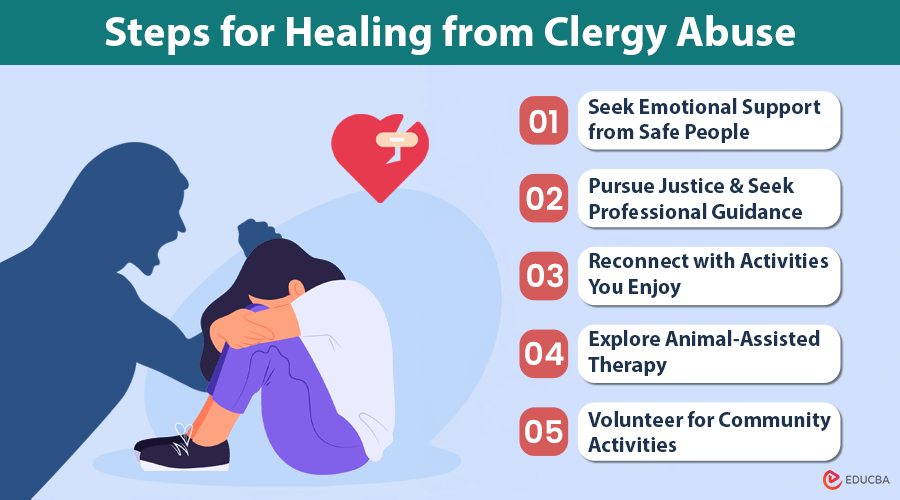Rebuilding Your Life
Healing from clergy abuse is a deeply personal journey that requires time, patience, and support. For many survivors, the hardest part is not just healing from the trauma—it is learning how to trust again. Abuse by a trusted figure can shatter the sense of safety that everyone deserves. This betrayal leaves emotional scars that may make it difficult to connect with others or believe in their worth.
While the path to recovery from clergy abuse is not always linear, it is possible. This article will share practical ways to rebuild confidence, regain control, and foster trust, starting with yourself. Each step will guide you toward a stronger, more hopeful future.
Practical Steps for Healing from Clergy Abuse
While the road to healing may be challenging, but with the right steps, you can rebuild trust and move forward toward a brighter future.
Step 1: Seek Emotional Support from Safe People
The first step in healing is finding people you can trust. A reliable support system helps you feel less alone and more understood as you work through difficult emotions. Safe people could be family members, close friends, mentors, or counselors—anyone who listens without judgment and respects your boundaries.
Professional therapy, especially trauma-informed counseling, provides survivors with coping tools to process their experiences healthily. Group therapy or peer support groups can also be incredibly helpful, connecting you with others who have faced similar challenges. Knowing you are not alone in your journey can be comforting and empowering.
Step 2: Pursue Justice and Seek Professional Guidance
Seeking justice can be a powerful step in the healing process. By holding abusers accountable, you reclaim your voice and send a powerful message that abuse will not be tolerated. You may wonder if taking action is necessary—but remember, speaking up can make a lasting difference for yourself and others. A comprehensive investigation by the Michigan Attorney General revealed abusive conduct involving 454 priests within Michigan, affecting over 800 survivors across the state. This shows how far-reaching the issue is and why standing up for justice matters.
If navigating legal steps feels overwhelming, you do not have to face it alone. With the help of knowledgeable lawyers, you can navigate the process and make sure your voice is heard while seeking compensation for therapy, medical expenses, and emotional distress. Seeking justice is not just about addressing the past—it is a step toward reclaiming your future.
Step 3: Reconnect with Activities You Enjoy
Trauma often leaves survivors feeling disconnected from themselves, but hobbies and interests can reignite a sense of normalcy and control. Start small by dedicating just a few minutes a day to a meaningful activity. Engaging in creative or calming pursuits can shift your focus from painful memories to moments of peace and fulfillment.
These activities remind you that your life is more than your trauma. Choosing things that make you feel good without the pressure to be perfect is essential. The goal is to enjoy the process, not the outcome. Slowly but surely, these small actions can help rebuild your confidence and reconnect you with the things that make you feel alive.
Step 4: Explore Animal-Assisted Therapy
Animal-assisted therapy (AAT) can offer comfort and support in a natural and non-judgmental way. Animals provide companionship that helps survivors feel safe, calm, and understood. This interaction can lower anxiety and create a sense of connection without the pressure of verbal communication. For many, simple activities like petting a dog, brushing a horse, or spending time with a therapy animal can be grounding and reassuring. Animals respond to emotions with unconditional acceptance, making it easier for survivors to relax and process their feelings.
Many certified programs offer individual or group settings tailored to emotional recovery. This approach does not replace traditional therapy but adds a layer of healing—helping survivors build trust, foster self-compassion, and take steps toward emotional growth.
Step 5: Volunteer for Community Activities
When you give your time to help others, you make a positive impact and rediscover your strengths and sense of purpose. Whether volunteering at a local food bank, taking part in charity events, or assisting at animal shelters, these activities foster a sense of belonging and connection.
The beauty of volunteering is that it shifts the focus from past trauma to making a difference in the present. It reminds you that you are capable and valued. Plus, small acts of kindness—both given and received—can bring moments of joy and purpose to your healing journey.
Final Thoughts
Healing from clergy abuse is undoubtedly challenging, but it is a journey you can overcome. The steps we have discussed can guide you toward meaningful recovery and a renewed sense of self. Remember, healing is not a race—it happens at your own pace. Some days may be harder than others, but every small step forward is still progress. Keep moving forward, and trust that with time, recovering from clergy abuse can lead to a brighter, more hopeful future.
Recommended Articles
We hope this guide on healing from clergy abuse offers support and insights on overcoming emotional and psychological challenges. Check out these recommended articles for additional resources and strategies for recovery and well-being.

